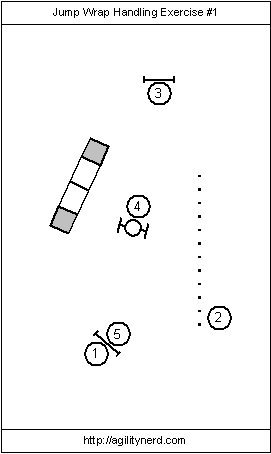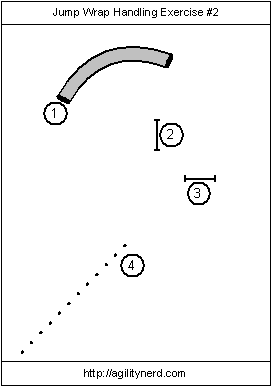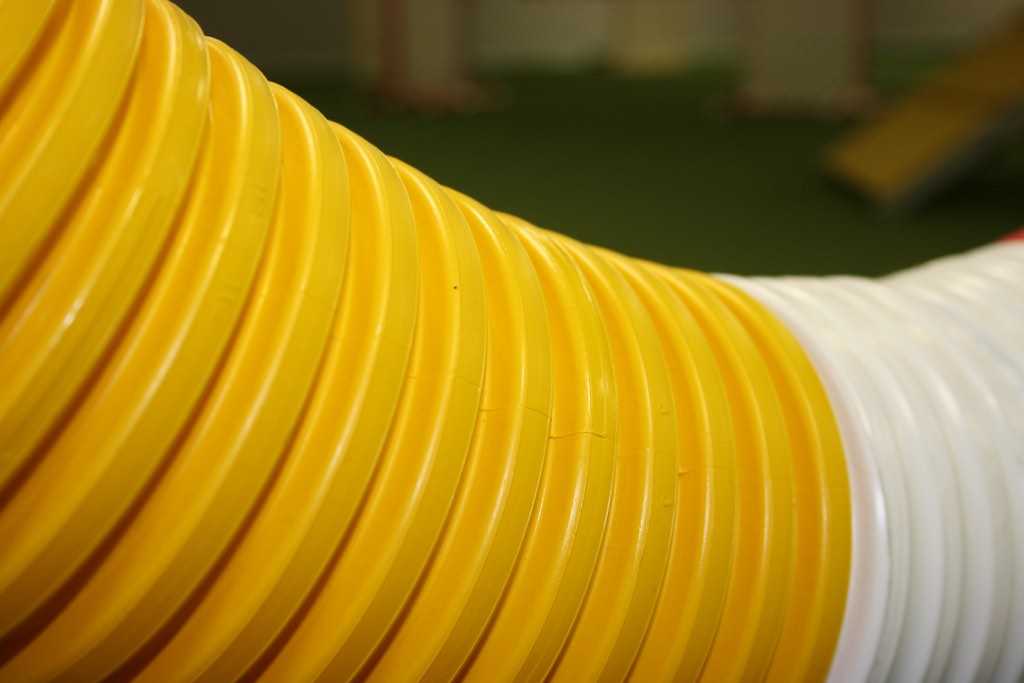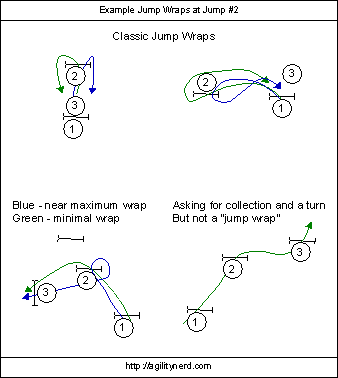Jump Wrap Handling - With Video
11 Apr 2011
The Jump Wrap is a very common handling maneuver where the goal is to have the dog collect as they approach the jump so that they can turn tightly around the jump and continue moving back in the general direction from which they came. In this article I’ll discuss and demonstrate all the ways I know for performing a Jump Wrap including the increasingly popular “Ketschker”.
The diagram below shows some examples of Jump Wraps.
As you can see in the diagram the jump wrap occurs when a dog jumps turning with collection in as little as 90 degrees or, conceivably, as much as 360 degrees. In my mind a turn over a jump becomes a jump wrap when the dog’s path goes back past the jump they just took.
The key to executing a jump wrap is to cue the wrap before the dog commits to the jump. When properly executed the dog will initiate their turn before jumping, exert the appropriate amount of energy, and land already turning. If the dog lands straight and then turns then the handler didn’t give the dog appropriate turning cues or was late in giving them to the dog.
The following sections describe different types of jump wraps. A video showing these wraps is presented at the end along with some simple example jump wrap sequences.

Post Turn/Shoulder Pull Jump Wrap
The Post Turn/Shoulder Pull Learning the Post TurnPost Turn/Shoulder Pull/Pivot Turn is one of the first ways handlers learn to wrap a dog around a jump. It has the advantage of being easy to execute, you just turn in place and your dog stays on the same side of the handler throughout.
A downside of the Shoulder Pull is it can cause wide jump wraps. Without other collection cues, putting your dog at your side and turning him over a jump with your lead arm out won’t bring your dog in tight to the jump standard.
To address this:
- Add additional collection cue(s) prior to the dog's commitment to the jump. For those used to Stuart Mah's terminology this would be switching the dog from obstacle focus to handler focus. Make eye contact, use dog's name, some people even have verbals to indicate a jump wrap (e.g. "step").
- Instead of the handler rotating while staying in mostly one spot, actually step backward as the dog lifts for the jump. This pulls the handler out of the dog's path and gives the dog another motion cue (backward motion) to come in toward the jump standard as they turn over the jump.
Front Cross Jump Wrap
The Front Cross Learning the Front Cross - VideoFront Cross jump wrap is the classic technique for wrapping the dog and changing sides of the dog. The dog is sent over the jump with deceleration cues and often using the arm nearest the dog to cue taking the jump. At some point the handler turns/rotates in toward the dog and presents his other arm as the new lead arm; thereby turning the dog and changing sides on the dog.
The “late” Front Cross jump wrap causes the dog to commit to the jump with out knowing it is turning and can cause a wide wrap.
"Reverse" Front Cross/"Backy Uppy" Jump Wrap
The Reverse Front Cross jump wrap is a variation of the Front Cross Jump Wrap where the handler faces the dog and cues the jump wrap by showing the dog the body and arm position for the second part of a classic front cross before the dog takes the jump. This arm motion/position is supported by the handler moving backwards; thereby showing motion to the jump. This technique provides tight jump wraps for dogs familiar with the cues.
Rear Cross Jump Wrap
When executed with the dog approaching perpendicular to the jump the Rear Cross Learning the Rear CrossRear Cross jump wrap can create wide jump wraps. The tightness of the turn can be somewhat controlled by how far behind the dog the handler is, how close to the jump the cross is performed, and how hard the handler pushes on the dog’s line.
The difficulty in tightening the wrap is the handler being behind the dog. Collection cues are limited to showing deceleration and verbal commands. Consequently the handler being ahead of the dog and closer to the jump allows the handler to show the deceleration and use that deceleration to turn the dog more sharply. Letting the dog get well ahead of the handler limits the dog’s ability to see the deceleration (they may commit to an extended stride when taking the jump before the cross is performed).
The speed at which the handler converges on the dog’s line the handler can also give the dog information on how tight to turn over the jump. Moving quickly and sharply across their path tends to tighten the turn (again as long as the dog hasn’t yet committed to the jump).
If the Rear Cross is performed with the dog approaching the jump at a sharp angle this technique can give a tighter wrap around the jump. An experienced team can also perform the wrap when approaching the jump from the side as shown in the diagram.
This type of wrap can be followed by a Front Cross to bring the dog in to the handler, restrict the dog’s path, and change back to the original side of the dog.
Scoop Jump Wrap
A “Scoop” is the application of the “end” of a Front Cross jump wrap where the handler and dog start out on different sides of the jump. The handler is on the landing side of the jump, the dog’s path converges on the handler and the dog jumps in toward the handler. The dog is picked up on the handler’s final arm of what would have been a Front Cross had the handler performed one.
The keys to executing a Scoop are training the dog to converge on the handler’s line and jump collected. The handler has to get ahead of the dog and be in position to get around the jump standard to complete the jump wrap.
Blind Cross Jump Wrap
The basic Blind Cross jump wrap starts as a Post Turn/Shoulder Pull and once the dog commits to the jump the handler accelerates and initiates the Blind Cross. Depending on the handler’s speed relative to the dog this can result in a wide wrap. The motion of the handler can also cue the dog to take nearby off course obstacles if the handler doesn’t reestablish contact with the dog immediately.
Reverse Front Cross to Blind Cross/"Ketschker"
Until recently I’d seen this version of the Blind Cross Jump Wrap only a couple times in the US. For a while there had been a trend to not use the Blind Cross at any time, mostly in reaction to poorly timed and/or poorly executed crosses causing dogs to turn wide and/or go off course. But like any tool the Blind Cross has advantages when executed properly and when applied appropriately.
A common rule, in handling systems that allow the Blind Cross, is to perform it when the dog is engaged in performing the obstacle. Initially, it was relegated to use on Non Turning Obstacles like tunnels, weaves and contacts. But it is being applied to other obstacles where the dog is committed and the Blind Cross can be completed before the dog is ready for its next cue.
The idea is simple, cue a Reverse Front Cross Jump Wrap and when the dog is committed to the obstacle, look over your other shoulder, step forward and present your other arm, the later part being the Blind Cross.
This works well in situations where the dog requires collections cues to get a tight wrap and it is easy on the handler (no Front Cross footwork required). Unlike a Front Cross Jump Wrap, with this handling the dog ends up on the opposite side of the handler after the wrap; which can be beneficial for the next part of the course.
I’d like to offer big thanks to Marq Cheek who did a lot of research to find out that this combination is referred to as a “Ketschker” and he found this YouTube video which contains comments as to the origin of the handling maneuver. In the video you can also see handlers applying this to 180s.
Video of Basic Jump Wraps
I’ve demonstrated these wraps in a video with a longer section on the “Ketschker” since that is less familiar.
The Jump Wrap In Action
This article is already quite long, so I’ll wrap up with a couple simple example sequences containing Jump Wraps. How many of these techniques can you apply on the wraps at obstacle 3 in each diagram? I’ll be posting a link to an article containing my solutions and some video in the next week or so; so we can compare notes.


I’ve posted a video of my handling solutions for these courses. Let me know if I missed your handling approach!
If you enjoyed this article won't you please:  Thanks!
Thanks!

